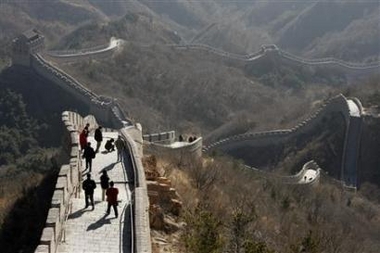Great Wall future more secure
(Reuters)Updated: 2006-12-16 10:18

Tourists visit the Great Wall of China in Badaling, on the outskirts of
Beijing December 9, 2006. (Claro Cortes IV/Reuters) 
BEIJING - Mongol hordes, Japanese soldiers and Red Guards -- China's Great Wall has seen them all off in its more than 2,000-year history.
Today, tourists, ravers and newly rich Beijingers on weekend jaunts are pounding parts of the wall to dust.
But a new law which came into effect on December 1, has left one campaigner hopeful about the wall's future.
"I'm optimistic about this century. The next 30 years are going to be a period where destruction of the wall is going to be much, much less," said William Lindesay, founder and director of International Friends of the Great Wall.
"I've seen more sites being reconstructed in an authentic way, and also I've discovered hope with local people and also determination amongst local officials," he told the Foreign Correspondents' Club in Beijing on Friday.
"They've realized that people come to China, and top of the list is the Great Wall of China," said the British geographer, who has just finished a project documenting how the wall has changed since the first pictures of it were taken 135 years ago.
The pressures on the wall are enormous.
Lindesay said that some parts now receive more visitors a month than they saw in the past three centuries combined.
"Finally I think the government's realized that the Great Wall is perceived by ordinary people as one of the great things of China," he said.
The Great Wall, which snakes its way across more than 6,400 km (4,000 miles), receives an estimated 10 million visitors a year, many to the 10 km segment open to tourists at Badaling, the nearest stretch to Beijing.
The wall, which the United Nations listed as a World Heritage Site in 1987, has been rebuilt many times through the centuries, and many sections of it have suffered serious damage from weather erosion and human destruction.
Visitors climb wilder, crumblier sections that are not officially open to the public and some stretches have become popular sites for summer raves.
"The last century couldn't have been much worse," Lindesay said. "Even into the 1990s I have seen farmers with hoes dismantling towers, putting the bricks in their baskets to carry downhill to build pig sties and outhouses and toilets."
Last month, police said three people had used excavators to take earth from the remains of part of the wall in Inner Mongolia to use as landfill for a village factory.
The village head protested that it was "just a pile of earth," state media reported.
The new law means that now people taking earth or bricks from the Great Wall can be fined up to 500,000 yuan ($63,950).
In another sign that the government was finally taking conservation seriously, Lindesay said the Badaling stretch -- so touristy it even has a Starbucks -- would undergo a radical facelift, with all development having to move 3 km back.
"It's not going to be easy," he said.
"The greatness of the Great Wall is its totality. If the gaps get larger, it's not such a great wall."
($1=7.819 Yuan)
|
||
|
||
|
|